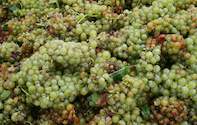To determine the ripeness of wine grapes, both the individual grape berries as well as bunches are tested to determine the following indicators of ripeness: Sugar level, acidity, colour, flavour and pH.

When berries and bunches are picked for testing, care must be taken not to pick from only one spot in the vineyard as this section of the vineyard may not be representative of the whole block. Pick from various parts of the vineyard, from the outside as well as inside rows as well as on the ‘sunny' and ‘shade' sides of the vines.
The picking test bunches are normally done just after colouring of the bunches have started, when berries are starting to soften, then weekly and then every second day until harvest time. These samples are taken to a laboratory.
Here, berries are crushed, mixed and the sugar levels, acidity and pH are measured. This is recorded with the date, vineyard or block number and cultivar of each sample. The increase in ripeness can be plotted and a possible harvest date can be predicted according to the results.